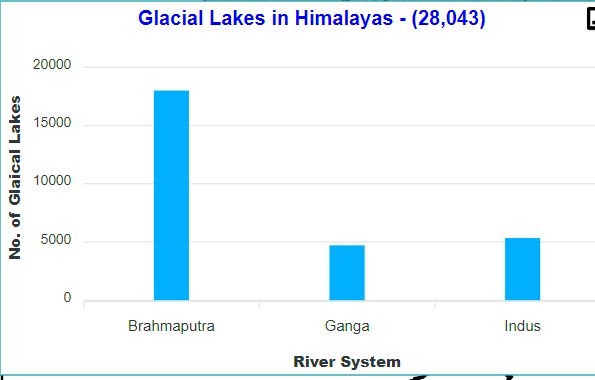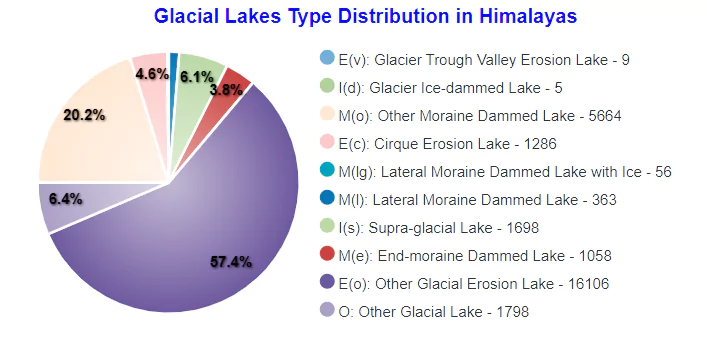Context
Uttarakhand government has formed expert teams to assess the risk of five glacial lakes prone to Glacial Lake Outburst Floods (GLOFs) in the Himalayas.
NDMA Identifies Five Glacial Lakes of Uttarakhand Are in Highest Risk
- The National Disaster Management Authority (NDMA), under the Ministry of Home Affairs, has identified 188 Himalayan glacial lakes prone to breaching due to heavy rainfall.
- Thirteen of these lakes are in Uttarakhand
- These lakes have been categorized into three risk levels: ‘A’, ‘B’, and ‘C’, based on their susceptibility to GLOFs.
- Five glacial lakes are classified as highly sensitive (‘A’ category) due to their increased risk of GLOFs.
- These lakes include Vasudhara Tal in the Dhauliganga basin in Chamoli district.
- Four lakes are in Pithoragarh district:
 Maban Lake in Lassar Yangti Valley, Pyungru Lake in the Darma basin.
Maban Lake in Lassar Yangti Valley, Pyungru Lake in the Darma basin.- The Two unclassified lakes are in the Darma and Kuthi Yangti Valley.
- The areas of these five lakes range from 0.02 to 0.50 square kilometers.
- They are situated at elevations ranging from 4,351 meters to 4,868 meters above sea level.
What is Glacial Lake?
- Glacial lakes are water bodies formed from melting glaciers.
- Distribution of lakes: Glacial lakes are commonly situated in close proximity to the edges of glaciers and ice sheets.
 Ice-contact lakes: Initially, these lakes are connected to the ice, known as ice-contact lakes.
Ice-contact lakes: Initially, these lakes are connected to the ice, known as ice-contact lakes.- Ice-distal lakes: As glaciers move and retreat, these lakes become separated from the ice, transitioning into ice-distal lakes.
- Types of sediments: These lakes contain sediments like organic muds, glacial clays, silty clays, and sands, depending on how and when they were formed.
- Factors affecting distribution of sediments: The surrounding drainage basin and the chemical makeup of the water.
Formation of Glacial Lake
- Carving of land and making hollows: When glaciers move across the land, it carves the land and makes hollows.
- Filling of hollows: Later, when the glacier melts, the hollows get filled with water, creating a glacial lake
What are Glacial Lake outburst Floods?

- Definition: Glacial lake outburst floods (GLOFs) are sudden releases of water and sediment from lakes blocked by natural barriers like moraines or glacier ice.
- These are known for the most powerful freshwater floods, with immense volumes, discharges, and sediment transport rates.
- Formation of landscapes: They reshape landscapes by causing erosion, sediment buildup, and changes in river courses.
- Factors causing expansion: As glaciers retreat and glacial lakes expand due to climate change, the risk posed by GLOFs is growing.
Causes of Glacial Lake Outburst Floods
- Dam formation: These lakes form when melted glacier water collects in depressions created by glacier activity, like rocks, sediment, and ice.
- Triggering Events: GLOFs are often triggered by events like ice or rock falling, earthquakes, or heavy rainfall, weakening or breaking the natural dams and causing sudden water release.
- Global temperatures: GLOF events have increased due to rising global temperatures as Warmer temperatures can weaken the ice or sediment barriers holding back the water, making them more susceptible to breaking.
- According to a 2021 study titled ‘Locked Houses, Fallow Lands: Climate Change and Migration in Uttarakhand, India’, the hill’s annual average maximum temperature may increase by 1.6-1.9 degrees Celsius.
- This temperature rise is projected to occur between the years 2021 and 2050.
Glacial Lake Outburst Floods Mitigation Measures
- GLOF Mitigation measures aim to reduce the volume of water to reduce risk of flood.
- It can be mitigated using various techniques.
- Controlled Breaching of Moraine Dam: Intentional Breaching of moraine dam controls water release from the glocal lake.
- Construction of Outlet Control Structure: This technique includes building an outlet control structure. This structure helps to regulate water and controls water release.
- Pumping or Siphoning Water: Using pumps to reduce water helps to control water volume. In this way, it reduces hydrostatic pressure on the moraine dam which further reduces GLOF event.
- Tunnelling Through Moraine Barrier or Under Ice Dam: This technique provides an alternative path for water to flow, leading to reduction in sudden outburst of GLOF events.
- Mechanism used for GLOF Mitigation
- Early warning/Monitoring: Early warning is a provision of timely and effective information by the institutions to reduce risk of catastrophe.
- Monitoring helps to detect instability of glacial lakes through remote sensing technologies such as satellite imagery and aerial surveys.
- Effective monitoring and early warning systems help to prepare for disaster in time.
- In India, various measures have been established at Sutlej River basin.
- Similarly, Telemetry stations have been established at Sumdo and Khaab, where rivers converge.
- In addition to above, The Naptha-Jhakri project at Dubling helps to monitor water levels.
Glacial Lake Outburst Floods in Uttarakhand
Uttarakhand witnessed two significant GLOF events so far:
- Kedarnath valley: This event happened in June 2013, affecting Kedarnath valley with significant loss of life.
- Chamoli district: This Glof event occurred in February 2021, causing flash floods in Chamoli district due to a glacier lake burst.
Also Read: Supreme Court Approves Shimla Development Plan 2041
![]() 4 Apr 2024
4 Apr 2024
 Maban Lake in Lassar Yangti Valley, Pyungru Lake in the Darma basin.
Maban Lake in Lassar Yangti Valley, Pyungru Lake in the Darma basin. Ice-contact lakes: Initially, these lakes are connected to the ice, known as ice-contact lakes.
Ice-contact lakes: Initially, these lakes are connected to the ice, known as ice-contact lakes.
